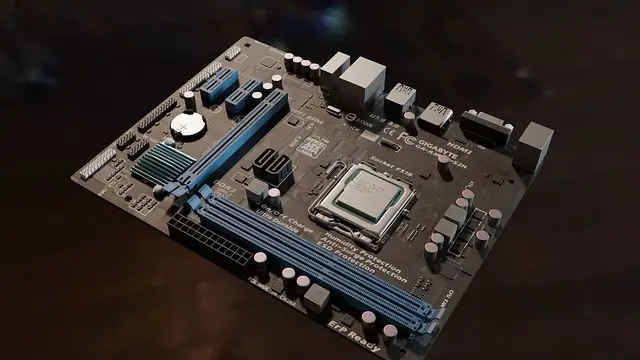The term “Bricked” in the tech industry refers to something that has become useless and there’s nothing you can do to fix it. Electronic components become faulty due to several reasons.
A Bricked Motherboard is used for a motherboard that is out of order or is dead completely. There are very narrow chances of fixing a bricked motherboard. A failed BIOS update is often responsible for making the motherboard bricked permanently.
The Simple Definition of a Bricked Motherboard
Generally, the term is applicable to the motherboards where the BIOS/UEFI chip is unusable due to inappropriate BIOS updates. Mostly this happens when you are trying to flash a firmware upgrade while running your operating system (Windows). If the flash fails, there are higher chances of your motherboard getting bricked.
So, it’s recommended to use the built-in BIOS/UEFI program first or any BOOT media (USB, Floppy Disk, CD/DVD) as a second choice to update your BIOS.
“Bricking” usually means that a device is unable to start up due to faulty software. It’s fairly hard to troubleshoot a bricked device to make it work again. But there are some possible fixes to overcome this issue.
What Are the Main Reasons Behind a Bricked Motherboard?
Here are some of the possible reasons:
Bad or Corrupted BIOS
BIOS or firmware in a computer is similar to the firmware that you find in your mobile phones. BIOS stands for Basic Input Output System and is the most basic program that runs when you turn on your computer.
This s the program that’s responsible for communication among different hardware connected to your computer. So, if there’s something wrong with your BIOS, then there would be no means of communication between your hardware.
BIOS is pre-installed on your motherboard by the manufacturer. So, if your BIOS is corrupted or improperly updated, this will lead to motherboard bricking.
BIOS Not Fully Updated
While updating your BIOS, if there’s a power outage, then there are higher chances of bricking your motherboard. This is the reason why you see messages that say “Do not turn off your device before the update is complete“.
It’s because the new software is being flashed on the ROM and any interruption could cause serious performance issues if you turn off your computer.
Damaged BIOS Chip
As we’ve discussed earlier, the BIOS is pre-installed on a small chip on your motherboard by the manufacturer. So, if the BIOS chip gets damaged, then your motherboard would become useless in no time.
Failing Power Supply
Motherboard draws anywhere between 50W to 150W of power out of your PSU. And if your power supply is failing, then this could end up in short circuits on your motherboard.
As a motherboard is mostly build-up of capacitors, MOSFETS, and chips, a bad power supply could affect one of these components, resulting in the death of the motherboard. Always check your power supply to make sure it’s in a healthy state.
Overclocking
Not every motherboard is designed for overclocking. And if you’ll put more stress on your motherboard, then this could bring you to the brink of bricking your motherboard.
So, if you are trying to overclock your CPU, make sure that your motherboard supports those speeds without any risks.
But keep in mind that there are less than 10% chances of a motherboard getting bricked due to overclocking.
Easy Way to Fix a Bricked Motherboard?
Now you know what are the main reasons behind this scenario, let’s discuss some proven methods to overcome this issue:
Removing the BIOS Chip
As the main culprit is the BIOS chip that has gone faulty, the only way around this is to take the faulty chip out and replace it with a new one.
Like we’ve said earlier, it’s not an easy task to fix a bricked motherboard, and you will need a little bit of knowledge of PC hardware to do this. But if you are not comfortable doing this, you can ask a computer technician to do this for you.
First of all, locate the BIOS chip on your motherboard. Every motherboard is designed differently, so you’ll have to locate your BIOS chip with the help of your motherboard manual.
And if you don’t have the motherboard manual with you, then you can simply search the name of your motherboard model on Google and then head over to the manufacturer’s website to find this out.
Just simply type the “name of your motherboard + location of BIOS chip” and you’ll find a lot of forums or websites on this.
Now here’s a video that shows you how to replace a BIOS chip on your motherboard by Garage Maxed Out.
This video would guide you through all the materials that you would need to change a BIOS chip effectively.
Also, BIOS chips are cheaper, you can get one for $6 to $10 dollars on eBay depending on the model of your motherboard.
If you have never opened a computer case ever in your life, then it’s better to take your motherboard to a local computer shop to get it fixed.
Bottom Line
So, this is how you can fix a bricked motherboard easily at home. But doing all this would need you to have a little bit of knowledge of PC hardware and soldering.
There are some other methods like flashing ROM, but you’ll need more luck, in that case, to get your motherboard working again. Removing and replacing the BIOS chip is the only way to bring back a bricked motherboard to life again.
If you have any working methods in mind, don’t forget to share them with us in the comment section.

Hi, this is Masab, the Founder of PC Building Lab. I’m a PC enthusiast who loves to share the prior knowledge and experience that I have with computers. Well, troubleshooting computers is in my DNA, what else I could say….

